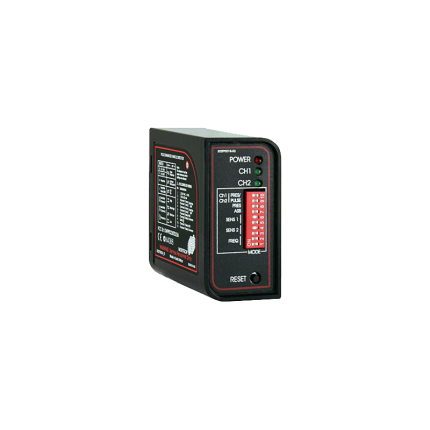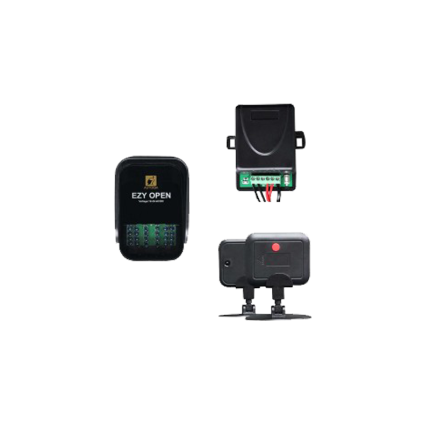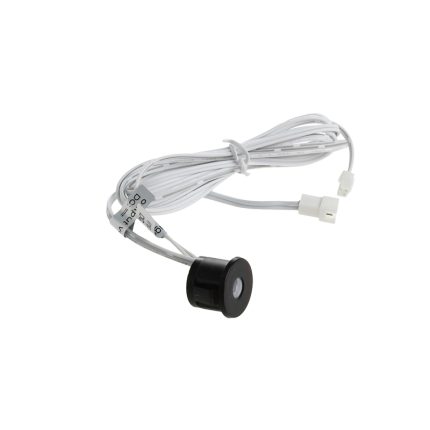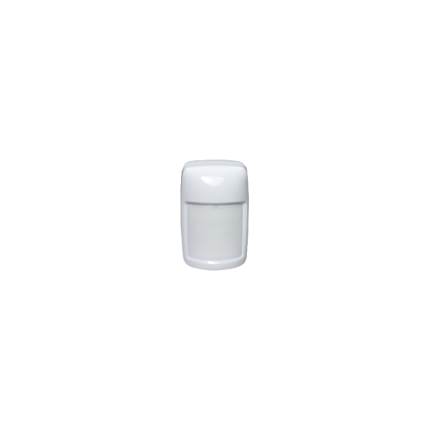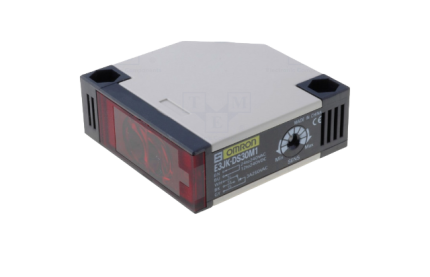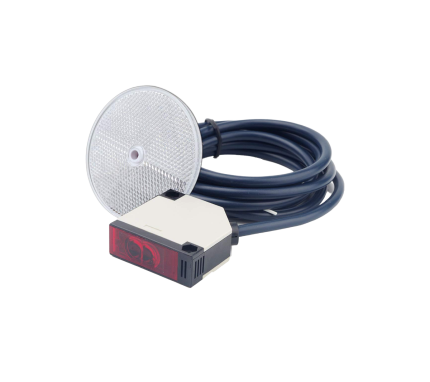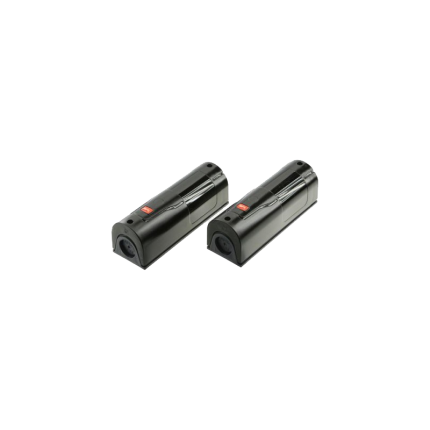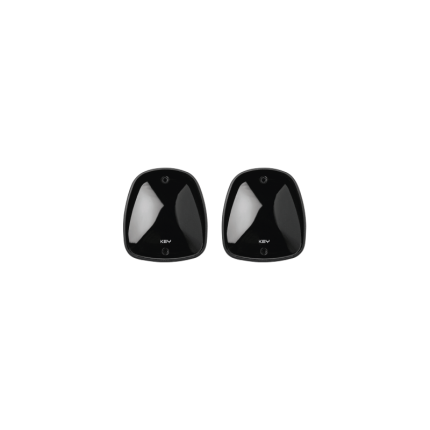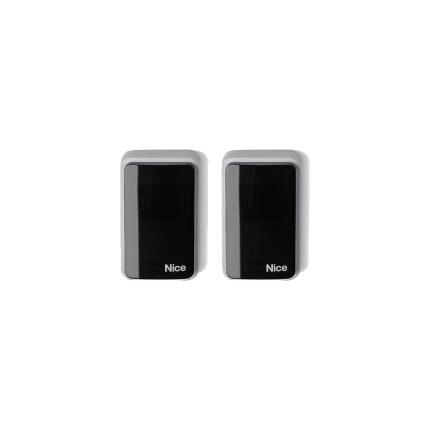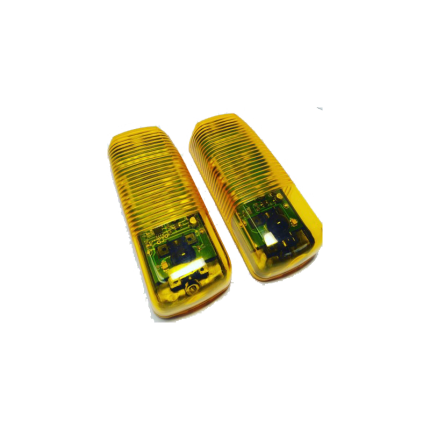sensor
Exit Loop Detector
Ship or pick up from our office.
Exit Loop Detector
An exit loop detector is a system designed to automatically open gates or barriers for vehicles leaving a secured area. It works primarily on the principle of electromagnetic induction and is a common component in automated access control systems for driveways, parking lots, and commercial properties. Here's how it generally works:- Inductive Loop: A wire loop, usually rectangular, is buried beneath the surface of the driveway or exit lane. This loop is connected to a loop detector unit.
- Electromagnetic Field: The loop detector sends an alternating current through the wire loop, creating a continuous electromagnetic field around it.
- Vehicle Detection: When a vehicle (which contains a significant amount of metal) drives over or within the range of this electromagnetic field, it disrupts the field. This disruption causes a change in the loop's inductance.
- Signal to Gate Operator: The loop detector senses this change in inductance and sends a signal to the gate or barrier's control system.
- Automatic Opening: Upon receiving the signal, the gate operator is triggered to open, allowing the vehicle to exit without requiring a remote control, keypad, or manual intervention.
Exit Wand Car Detector
Ship or pick up from our office.
Exit Wand Car Detector
An Exit Wand Car Detector, also known as a magnetometer or vehicle sensor, works by sensing changes in the Earth's magnetic field caused by the movement of metal objects, specifically vehicles. Here's a more detailed breakdown of how it operates:- Magnetometer: The core of an exit wand is a magnetometer. This device is highly sensitive to variations in magnetic fields.
- Earth's Magnetic Field: The Earth naturally has a magnetic field surrounding it.
- Vehicle Movement: When a large mass of ferrous metal, like a car, truck, or even a heavy piece of metal equipment, moves through this magnetic field, it creates a disturbance or distortion in the field. Think of it like a boat creating waves as it moves through water.
- Detection: The exit wand's magnetometer picks up on these subtle "waves" or changes in the magnetic field as the vehicle passes by.
- Signal to Gate Opener: Once the changes are detected and exceed a certain threshold (which is often adjustable for sensitivity), the exit wand sends a signal to the gate opener's control board.
- Gate Activation: The gate opener, upon receiving this signal, then automatically opens the gate, allowing the vehicle to exit the property "hands-free" – without the need for a remote, keypad, or manual intervention.
- Motion-Activated: A crucial point is that exit wands primarily detect moving metal. If a car is stopped directly over the wand, it may lose detection.
- Buried Installation: Exit wands are typically buried underground, often alongside the driveway, making them discreet and protected from weather and accidental damage.
- Sensitivity Adjustment: Most exit wands have an adjustable sensitivity. This allows you to fine-tune how easily it triggers, helping to prevent false alarms from smaller metal objects like bicycles or lawnmowers, or to ensure it detects vehicles at a desired range.
- Wiring: Wired exit wands have a cable that connects the wand to the gate opener's control box. Wireless versions transmit the signal wirelessly to a receiver connected to the gate opener.
- Not for Safety Loops: While they are excellent for automatic exit, exit wands are generally not recommended for use as safety loops. Safety loops (which are different, typically inductive loops buried in the driveway itself) are designed to detect any presence of metal, moving or stationary, to prevent the gate from closing on a vehicle.
- Limitations: They can sometimes be triggered by very large or fast-moving metal objects even if they are not cars. Also, if they are placed too close to the gate, they might experience false triggers.
Gate Opener Infrared Remote
Ship or pick up from our office.
Gate Opener Infrared Remote
An infrared remote for an automatic gate opener allows you to control your gate from a distance, while the infrared sensor provides safety by detecting obstacles and automatically reversing the gate's movement if an obstruction is encountered.Here's a breakdown:
-
Infrared (IR) Remote:This is a standard remote control, similar to those used for televisions, that transmits a signal to the gate opener using infrared light. You press a button on the remote, and it sends a coded signal to the gate opener's receiver, which then activates the gate motor.
-
Infrared (IR) Sensor:This sensor, often found near the gate, emits an infrared beam. If an object (like a person or car) breaks this beam while the gate is closing, the sensor detects the interruption and signals the gate opener to stop and potentially reverse its direction to prevent accidents.
-
Auto-Open/Close Functionality:Many automatic gate openers also have an "auto-close" feature, allowing you to set a timer for the gate to automatically close after a certain period (e.g., 5, 10, or 20 seconds). This adds convenience by eliminating the need to manually close the gate.
-
Remote Range:The range of the remote control can vary, but typical ranges are around 100 feet (30 meters). Some systems can handle a larger number of remote controls (e.g., up to 25).
-
Safety and Security:The infrared sensor adds a layer of safety to your gate system. The automatic reversing feature helps prevent accidents and property damage.
-
Other Features:Some automatic gate openers also include features like:
- Manual release: Allows you to manually open and close the gate in case of power outages or other emergencies.
- Overheating protection: The motor may have a built-in protection mechanism to prevent overheating.
- Multiple control options: Some systems can also be controlled via a wireless keypad or even through a smartphone app.
Infrared PIR Motion Sensor Switch
Ship or pick up from our office.
Infrared PIR Motion Sensor Switch
An Infrared PIR Motion Sensor Switch is an electronic device that detects movement by sensing changes in infrared (IR) radiation in its field of view. "PIR" stands for Passive Infrared, meaning it doesn't emit any energy itself but rather passively monitors the infrared radiation given off by objects. 🌡️ How it Works At the core of a PIR sensor is a pyroelectric sensor, which is sensitive to heat (infrared radiation). Most PIR sensors have two halves, or "slots," wired in a differential arrangement. Here's a simplified breakdown of its operation:- Idle State: When there's no movement, both halves of the sensor detect the same amount of ambient infrared radiation from the surroundings.
- Motion Detection: When a warm object, like a human or animal, moves into the sensor's field of view, it first intercepts one half of the sensor, creating a temporary difference in the infrared radiation detected by the two halves. This difference generates a voltage pulse.
- Signal Processing: The sensor's circuitry processes this voltage pulse. If the change is significant and matches the pattern of a moving heat source, the sensor triggers an output signal.
- Fresnel Lens: A key component of a PIR sensor is the Fresnel lens . This specially designed plastic lens focuses infrared radiation from different angles onto the pyroelectric sensor, effectively dividing the detection area into multiple sensitive zones. This allows the sensor to have a wider field of view and detect movement more effectively.
- Automatic Lighting Control: This is one of the most common applications. PIR sensors turn lights on when someone enters a room, hallway, or outdoor area and turn them off after a set period of no motion, saving energy.
- Security Systems: They are integral to security alarms, detecting intruders and triggering alerts or security cameras.
- Smart Home Systems: PIR sensors play a role in smart homes for automating various functions, from lighting and HVAC systems to controlling appliances based on occupancy.
- Automatic Doors: In public buildings, they detect approaching individuals to automatically open doors.
- Energy Management: By ensuring that lights, HVAC, and other devices only operate when an area is occupied, PIR sensors contribute significantly to energy savings in residential and commercial settings.
- Wildlife Tracking and Research: Researchers use them to monitor animal movements without disturbance.
PIR Infrared Sensor – wired
Ship or pick up from our office.
PIR Infrared Sensor – wired
A PIR (Passive Infrared) sensor is an electronic sensor that detects infrared (IR) light radiating from objects within its field of view. It's called "passive" because it doesn't emit any energy itself; instead, it passively monitors the existing infrared radiation in its surroundings. All objects with a temperature above absolute zero emit some level of infrared radiation, and the hotter an object, the more radiation it emits. PIR sensors are particularly effective at detecting the infrared radiation emitted by warm bodies, such as humans and animals. How PIR Sensors Work At the core of a PIR sensor is a pyroelectric sensor, a material that generates an electrical charge when exposed to changes in infrared radiation. To detect motion, most PIR sensors use a dual-sensor design:- Dual Elements: The pyroelectric sensor is typically divided into two halves or elements, wired in a way that they cancel each other out when no motion is detected. This means that if both halves receive the same amount of IR radiation (e.g., from the ambient room temperature), their signals balance, and no output is generated.
- Fresnel Lens: A Fresnel lens is often placed in front of the pyroelectric sensor. This special lens has multiple facets that help to focus infrared light from different angles onto the sensor elements, increasing its range and sensitivity, and creating distinct detection zones.
- Motion Detection: When a warm object, like a person, moves across the sensor's field of view, it first enters one detection zone (and thus one half of the pyroelectric sensor) and then the other. This causes a differential change in the amount of infrared radiation impinging on each half of the sensor. This difference in IR energy between the two halves creates an electrical signal.
- Signal Processing: The sensor's internal circuitry processes this change in voltage. If the change is significant enough (indicating a "moving heat source"), the sensor triggers an output signal.
- Security Systems: The PIR infrared sensor are a fundamental component of burglar alarms and motion-activated security cameras, detecting intruders by their body heat.
- Automatic Lighting: PIR infrared sensors are used in homes, offices, and public spaces to automatically turn lights on when someone enters a room or area and off when it's unoccupied, leading to energy savings.
- Smart Home Automation: The PIR infrared sensor play a crucial role in smart homes, triggering various automated actions like adjusting thermostats, turning on appliances, or opening doors based on occupancy.
- Automatic Doors: Many automatic door systems, like those found in shopping malls, use PIR sensors to detect approaching individuals and open the doors.
- Industrial Monitoring: They can be used to monitor machinery movement or detect the presence of personnel in hazardous areas for safety purposes.
- Wildlife Tracking and Research: Researchers use them to monitor animal movements unobtrusively.
PIR Infrared Sensor – wireless
Ship or pick up from our office.
PIR Infrared Sensor – wireless
A wireless PIR (Passive Infrared) sensor is a type of motion detector that uses infrared technology to detect the presence and movement of people, animals, or other warm objects within its field of view, and then transmits this information wirelessly to a central control unit. Here's a breakdown of its key aspects: PIR (Passive Infrared) Technology:- Passive: The "passive" in PIR means the sensor does not emit any energy (like radar or ultrasonic sensors do). Instead, it "passively" detects the infrared radiation (heat energy) naturally emitted by all objects with a temperature above absolute zero.
- Infrared Detection: All living beings (humans, pets) and warm objects emit infrared radiation.
- How it works: A PIR sensor typically has two sensing elements within its housing. When no motion is present, both elements detect the same amount of infrared radiation from the ambient environment. When a warm body moves across the sensor's field of view, it first enters one sensing element's range, causing a rapid change in the infrared energy detected by that element. As the body moves further, it then affects the second element. This differential change in infrared energy between the two elements is what the sensor interprets as motion.
- Fresnel Lens: PIR sensors often have a specialized faceted lens (a Fresnel lens) on their front. This lens helps to focus the infrared radiation onto the sensing elements and creates multiple "detection zones" or "fingers" within the sensor's field of view, which increases its coverage and sensitivity.
- No Wires for Communication: The "wireless" aspect means the sensor communicates with the alarm system's control panel (or receiver) using radio frequencies (RF) rather than physical wires.
- Battery Powered: Wireless PIR sensors are usually battery-powered, making them easy to install anywhere without needing to run electrical wiring. The batteries typically last for a significant period (months to years) before needing replacement.
- Transmitter: Each sensor has a small radio transmitter that sends a signal to the central alarm panel when motion is detected.
- Receiver: The alarm control panel has a built-in or external wireless receiver that listens for signals from the PIR sensors (and other wireless sensors like door/window contacts).
- Easy Installation: No need for complex wiring, making DIY installation simpler and reducing labor costs for professional installers. This is a significant advantage in existing structures where running wires might be difficult or aesthetically unappealing.
- Flexible Placement: Can be mounted virtually anywhere within their effective range of the control panel, providing versatile coverage.
- Reduced False Alarms (Compared to Simple Motion Detectors): Because PIR sensors detect heat signatures, they are less likely to be triggered by non-living things like swaying curtains, blowing leaves, or shadows (though extreme drafts or sudden temperature changes can still be an issue if not properly installed).
- Pet Immunity: Many wireless PIR sensors offer "pet immunity" features. These sensors are designed to ignore the infrared signatures of smaller animals (below a certain weight, e.g., 40 lbs or 80 lbs), helping to prevent false alarms in homes with pets. This is achieved by adjusting the sensor's lens and internal logic to focus on specific infrared patterns that are indicative of human-sized targets.
- Energy Efficiency: As passive devices, they consume very little power, contributing to long battery life.
- Comprehensive Coverage: Ideal for protecting large areas or rooms, as a single sensor can cover a significant space.
- Integration: Seamlessly integrate with smart home security systems, allowing for remote monitoring, alerts via smartphone apps, and sometimes even integration with other smart devices (e.g., turning on lights when motion is detected).
- Home Security Systems: Widely used indoors to detect intruders in living rooms, hallways, bedrooms, and basements. Outdoor-rated versions are also available for perimeter protection.
- Commercial Security Systems: Protecting offices, warehouses, retail spaces, and other commercial properties.
- Automated Lighting: Activating lights in rooms, hallways, or outdoor areas when someone enters.
- Smart Home Automation: Triggering various smart home routines based on occupancy (e.g., adjusting thermostat, playing music).
- Access Control: Monitoring movement in restricted areas.
- Placement: Proper placement is crucial to avoid false alarms. Avoid aiming them directly at heat sources (vents, radiators, direct sunlight, fireplaces), areas with strong drafts, or windows (especially those exposed to direct sun or busy outdoor activity).
- Pet Immunity Settings: If you have pets, ensure the sensor has pet immunity and that it's set correctly for your pet's size and the sensor's mounting height.
- Signal Range: Ensure the sensor is within the wireless range of your alarm panel, considering walls and other obstructions that might weaken the signal.
- Battery Life: Be mindful of battery replacement schedules to ensure continuous operation.
Reflective safety sensor – OMRON E3JK
Ship or pick up from our office.
Reflective safety sensor – OMRON E3JK
*NO/NC *AC/DC 24-240 V *Receiving Range: 40 Meters *IP 64Safety sensor – BFT FL130
Ship or pick up from our office.
Safety sensor - BFT FL130
The BFT FL130 is a photoelectric safety sensor designed primarily for use with automated gates and doors. It's a crucial safety component that prevents the gate or door from closing if an obstacle, such as a person or vehicle, is detected in its path. Here's a breakdown of its key aspects: How it Works The BFT FL130 operates as a pair of photocells, consisting of a transmitter (TX) and a receiver (RX). These units are typically mounted on opposite sides of the gate or door opening. The transmitter emits an infrared beam towards the receiver. If anything breaks this beam (e.g., a person walking through, a car passing), the receiver detects the interruption and sends a signal to the gate's control unit. This signal then triggers a safety mechanism, causing the gate to stop its movement or reverse direction to avoid impact. Features and Specifications- Type: Photoelectric safety sensor (photocell).
- Components: Transmitter and receiver pair.
- Function: Detects obstacles in the path of automated gates and doors to prevent accidents.
- Detection Method: Infrared beam.
- Applications: Commonly used in residential and commercial settings for automated swing gates, sliding gates, and garage doors.
- Max Range: Up to 30 meters (can be reduced by 50% in adverse weather conditions like fog or heavy rain).
- Power Supply: Typically 20-31 VAC or 22-30 VDC.
- Absorption: Approximately 70mA per pair.
- Relay Contacts: 1A at 24 VAC-DC.
- Working Temperature: Generally from -15°C to +70°C (some sources say -5°C to +70°C).
- Protection Rating: IP54, meaning it's protected against dust ingress and splashing water.
- Mounting: Should be aligned and mounted at a height between 40 and 60 cm from the ground on flat, parallel surfaces.
- Dimensions: Compact, typically around 115mm x 32mm x 26mm.
- Versions: There is also a BFT FL130B version, which may offer additional features like self-alignment and is designed to meet EN12453 regulations for Type D safety devices when connected to a compatible control unit that verifies safety device functionality.
Safety Sensor – Key Automation 900FT33
Ship or pick up from our office.
Safety Sensor - Key Automation 900FT33
- NO/NC
- AC 10-30 V / DC 10-40 V
- Receiving Range: 25 Meters
- IP 54
Safety sensor – Nice Era-EPM
Ship or pick up from our office.
Safety sensor - Nice Era-EPM
The Nice Era-EPM is a photoelectric safety sensor commonly used in automation systems for gates, garage doors, barriers, and similar installations. It's also often referred to as a photocell or beam sensor. Here's a breakdown of what it is and its key features: Purpose: Its primary function is to enhance safety by detecting obstacles in the path of a moving gate or door. It consists of a transmitter (TX) and a receiver (RX) that are installed facing each other. The transmitter emits an infrared beam, and if this beam is interrupted by an object, the receiver signals the control unit to stop or reverse the automation system, preventing accidents, injuries, or damage to vehicles. Key Features and Specifications:- Photoelectric Technology: It uses an infrared beam to detect obstructions.
- Transmitter (TX) and Receiver (RX): Comes as a pair, with one unit transmitting the beam and the other receiving it.
- Relay Output: It's a relay photocell, meaning it sends a signal to the control unit via a relay output.
- Range: Typically has a useful range of 15 meters, which can be extended up to 30 meters in some configurations (e.g., by cutting a "+10m" electrical bridge). However, range can be reduced in adverse weather conditions like fog, rain, or dust.
- Anti-Glare Circuitry: Designed with an anti-glare circuit to minimize interference from sunlight, ensuring reliable performance in various lighting conditions.
- Durable Construction: Features an ABS body that is resistant to weather conditions, making it suitable for outdoor use (IP44 protection rating).
- Easy Installation: Known for its simplified assembly and installation procedure. Some versions (like those with Nice BlueBUS technology) require only two wires for connection to compatible control units, simplifying wiring.
- Wide Angle of Reception: Generally has a 10° (or 8° with a reduction cone) angle of reception, which helps in compensating for minor alignment issues.
- Compatibility: While it's a Nice-branded product, it's often described as a "universal photocell" compatible with most gate and garage door automation systems, especially those that accept standard relay inputs. Some models also feature Nice BlueBUS technology for seamless integration with Nice control units that support it.
- Safety Compliance: It is a Type D presence detector according to EN 12453 standard, which means it detects obstacles on the optical axis. When connected to a control unit with a "phototest" function, it can achieve Category 2 safety against malfunctions according to EN 954-1.
Safety sensor – P51033H
Ship or pick up from our office.
Safety sensor - P51033H
*NO/NC *AC/DC 12-24 V *Receiving Range: 12 Meters *IP 54 *External LED flash lamp signal (AC/DC 12V-24 V) *The P51033H safety sensor included the LED flash light The P51033H is a safety sensor, specifically a photoelectric sensor (also known as a photo eye) commonly used in automatic gate and door systems. What it Does 🚧 This sensor functions as an obstruction detection device. It consists of two parts: an emitter and a receiver. The emitter sends out an infrared light beam, and the receiver detects it. If an object (like a person, pet, or vehicle) interrupts this beam, the sensor sends a signal to the gate or door's control board, causing it to stop or reverse its movement, preventing potential injury or damage. Key Specifications ⚙️ Here are some of the technical details for the P51033H:- Working Voltage: 12~24VAC/DC
- Working Current (24VDC):
- Emitter:
- Receiver:
- Photocell Wavelength: (infrared)
- Angle of Opposite Emission:
- Receiver Range: (this range can be reduced by about in adverse weather conditions like fog, rain, or dust)
- Working Temperature:
- Relay Contact Loading Capacity:
- Waterproof Grade: IP54
- Size:
- Outputs: NO/NC (Normally Open/Normally Closed) contacts
- Height: More than above the ground to prevent false reflections.
- Distance between Emitter and Receiver: More than meters to ensure proper operation.
- Sunlight: The receiver should be installed away from direct sunlight or other strong light sources () to maintain stable operation.
- Multiple Sensors: If multiple photocells are installed on the same line, receivers can be placed at both ends and emitters in the middle, back-to-back, to prevent interference.
- Firm Installation: Install the photocell firmly to avoid signal bias between the emitter and receiver, which could lead to malfunctions.

